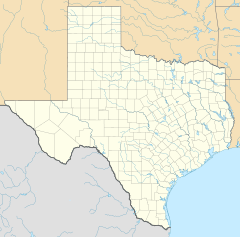Zodiac, Texas facts for kids
Quick facts for kids
Zodiac, Texas
|
|
|---|---|
| Country | United States |
| State | Texas |
| County | Gillespie |
| Elevation | 1,594 ft (486 m) |
| Time zone | UTC-6 (Central (CST)) |
| • Summer (DST) | UTC-5 (CDT) |
| Area code(s) | 830 |
| FIPS code | 48 |
| GNIS feature ID | 1378977 |
Zodiac was a small community that used to exist in Texas. It was founded in 1847 by a group of Mormon settlers. This settlement was located near the Pedernales River, about 4 miles southeast of Fredericksburg. Today, there are no signs left of Zodiac. The land where it once stood is now private property.
Zodiac was the first Mormon settlement started by Lyman Wight in Texas. He later founded two more settlements: Mormon Mill in 1851 and Mormon Camp in 1854. In 1936, Zodiac was recognized as a Recorded Texas Historic Landmark, which means it's an important historical site.
Contents
Zodiac: A Lost Texas Town
How Zodiac Started
Lyman Wight led about 200 followers to Texas in 1845. They first arrived in Grayson County and stayed there for the winter. In the spring of 1846, they moved on to Austin.
In Austin, the group worked as laborers, helping to build the city jail. They also built a sawmill and a gristmill (a mill for grinding grain) on the Colorado River. After these projects, the group decided to move towards the Texas Hill Country.
Building the Zodiac Community
In 1847, Wight received permission to create a Mormon settlement. This permission came from John O. Meusebach, who was in charge of the Adelsverein territory. This German community was welcoming to Wight's group because they believed in religious freedom. They also did not support slavery.
Once they settled on the Pedernales River, Wight and his followers began building their community. They constructed several important buildings:
- a chapel (a place for worship)
- a school
- a store
- a gristmill
- a sawmill
These businesses helped provide goods and services for the entire county. In 1848, Wight and his followers also helped build Fort Martin Scott, a military outpost.
Life in Zodiac
In 1850, a United States official named John Russell Bartlett visited Zodiac. He was working to carry out the rules of the Treaty of Guadalupe Hidalgo, which ended the Mexican-American War. Bartlett wrote about what he saw in Zodiac:
Everywhere around us in this Zodiacal settlement, we see abundant signs of prosperity... They have a tract of land which they have cultivated for about three years and which has yielded profitable crops. The well-built houses, perfect fences and tidy dooryards give the place a homelike air such as we had not seen before in Texas. The dinner was a regular old-fashioned New England farmer's meal comprised of an abundance of everything and served with faultless neatness. The entire charge for the dinner for twelve persons and corn for as many animals was $3.
Bartlett's account shows that Zodiac was a thriving and well-organized community. The settlers had good farms and comfortable homes.
Why Zodiac Disappeared
In 1851, the Pedernales River flooded badly. The flood waters destroyed the mills that the Mormon settlers had built. Because of this disaster, Wight and his followers decided to leave Zodiac.
They moved to Mormon Mill in Burnet County. Even after leaving, they kept the rights to the Zodiac cemetery in Gillespie County. Several people from their group had already been buried there. Lyman Wight himself died on March 31, 1858, and was buried in the Zodiac Cemetery.
After the Mormons left, different groups of settlers moved into the area. These included German, English, and Danish colonists.
Zodiac After the Civil War
Before and during the Civil War, the area that was once Zodiac became a large farm. This farm used forced labor to grow cotton. It is believed to be the only cotton farm of its kind in Gillespie County at that time. It's possible that Matthew Gaines, who later became a Texas State Senator, was forced to work on this property during the Civil War. In 1860, records show that Gillespie County had thirty-three people who were forced into labor.
In 1885, a school called Rocky Hill was built in the area. The name Zodiac was then changed to Rocky Hill, after the school. Sadly, the old cemetery was plowed over and destroyed. Today, the land where Zodiac once stood is private property.



